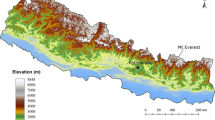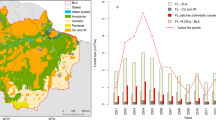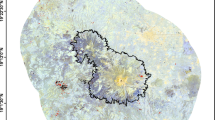Abstract
Despite the importance of the forest resources in tropical regions, forest continues to rapidly decrease due to demand from an ever increasing population. This study uses remote sensing to examine forest loss in the different forest types found in the Niger Delta of Nigeria from 1984 to 2011. The results show that the over utilization of forest resource in the past three decades has resulted in its degradation, particularly within protected areas in the Delta. However, the patterns and intensity of forest loss vary according to the type of forest. The majority of the forest reserves in lowland rainforests have lost over 40 % of their area, freshwater swamp forest reserves have lost about 30 %, whilst the reserves in mangrove forests have lost just 11 %. Deforestation is high in the lowland rainforest because the land is good for agriculture, but lower in freshwater swamp and mangrove forest because the land is covered in swamps and subjected to seasonal flooding, both of which limit accessibility. Drivers of forest loss in the region are complex, including illegal selective logging from both commercial loggers, due to high timber demand in cities and communal logging of firewood by local people used for domestic cooking.











Similar content being viewed by others
References
Adekunbi, E. (2011). The Rot in Okomu Oil, The Tell Magazine, Monday, 23 May 2011.
Akinsorotan, O. A., Ogunjemite, B. G., & Afolayan, T. A. (2011). Assessment of the large mammals of Arakhuan range, Okomu national park, Nigeria. Ethiopian Journal of Environmental Studies and Management, 4(3), 25–37.
Alagoa, E. J., & Derefaka, A. A. (2002). The land and people of riverstate: Eastern Niger Delta (pp. 53–83). Port Harcourt: Onyoma Research Publications.
Alaoga, E. J., Anozie, F. N., & Nzewunwa, N. (1988). The early history of the Niger Delta (pp. 16–18). Buske: Hamburg.
Barbour, K. M., Oguntoyinbo, J. S., Onyemelukwe, J. O. C., & Nwafor, J. C. (1982). Nigeria in maps. London: Hodder and Stoughton.
Blench, R., (2007). The mammals of the Niger Delta in Nigeria. The Kay Williamson Education Foundation (KWEF). [Online]. http://www.rogerblench.info/Ethnoscience%20data/Niger%20Delta%20mammal%20book.pdf. Accessed 8 March 2010.
Bown, D., Olasupo, O., & Peacock, J. (2011). Conservation of the IITA forest and its resources. The Nigerian Field, 76, 19–78.
Center for Environmental and Development in Africa [CEDA]. (1997). Coastal profile of Nigeria. Federal Environmental Protection Agency large Marine. Ecosystem Project for the Gulf of Guinean. CEDA, 1997.
Coastal News. (2010). Irele local government, Ondo state Nigeria. Sunday, 11 July 2010 09:48.
Ebeku, K. S. A. (2006). Oil and the Niger Delta people in international Law, resources right, environmental and equity issues (1st edn, pp. 18–360). Rudiger Kopper Verlay Koln.
Estes, A. B., Kuemmerle, T., Kushnir, H., Radeloff, V. C., & Shugart, H. H. (2012). Land-cover change and human population trends in the greater Serengeti ecosystem from 1984–2003. Biological Conservation, 147, 255–263.
Ezebilo, E. E., & Mattsson, L. (2010). Indigenous knowledge systems for promoting community conservation education in a Nigerian protected area. International Journal of Biology, 2(2), 149–157.
Geist, H. J. & Lambin, E. F. (2001). What drives tropical deforestation? A meta-analysis of proximate and underlying causes of deforestation based on subnational case study evidence. LUCC Report Series No. 4, University of Louvain Louvain-la-Neuve, Belgium.
Grubb, P., & Powell, C. B. (1999). Discovery of red colobus monkeys (Procolobus badius) in the Niger Delta with the description of a new and geographically isolated subspecies. Journal of Zoology, 248(1), 67–73.
Ibaba, S. (2010). Environmental protection laws and sustainable development in the Niger Delta. Africana, 4(2), 42–77
Ite, U. E. (1996). Community perceptions of the Cross River National Park, Nigeria. Environmental Conservation, 23(4), 351–357.
Ite, U. E. (2001). Global Thinking and local action, agriculture, tropical forest loss and conservation in Southeast Nigeria (pp. 29–123). England: Ashgate Publishing.
Ite, U. E. (2005). Tree integration in homestead farms in southeast Nigeria: propositions and evidence. The Geographical Journal, 171(3), 209–222.
Kalu, C., & Izekor, D. N. (2006). Evaluation of forest policy in Nigeria: A case study of Edo state. African Journal of Biotechnology, 5(5), 429–433.
Lambin, E. F., Geist, H., & Lepers, E. (2003). Dynamics of land use and cover change in tropical regions. Annual Review of Environment and Resources, 28, 205–241.
Lambin, E. F., Turner, B. L, I. I., Geist, H., Agbola, S., Angelsen, A., Bruce, J. W., et al. (2001). The causes of land-use and—cover change: moving beyond the Myths. Global Environmental Change, 11, 261–269.
Luiselli, L., & Akani, G. C. (2003). An indirect assessment of the effects of oil pollution on the diversity and functioning of turtle communities in the Niger Delta, Nigeria. Animal Biodiversity and Conservation, 26(1), 57–65.
Marcoux, A. (2000). Population and the environment: A review and concepts for population programmes. Part III: Population and deforestation. FAO, June 2000. [Online]. http://www.fao.org/sd/wpdirect/wpan0050.htm. Accessed 12 July 2014.
Menzies, N. (1988). Three hundred years of Taungya: A sustainable system of forestry in South China. Human Ecology, 16(4), 361–376.
Meyfroidt, P., & Lambin, E. F. (2008). Causes of the reforestation in Vietnam. Land Use Policy, 25, 182–197.
Morakinyo, T., & Tooze, Z. (2007). conservation of community forest and primates in the Cross river state, Nigeria. The Nigerian Field, 72, 126–138.
Mmom, P. C., & Arokoyu, S. B. (2010). Mangrove forest depletion, biodiversity loss and traditional resources management practices in the Niger Delta, Nigeria. Research Journal of Applied Sciences, Engineering and Technology, 2(1), 28–34.
Niger Delta Regional Development Master-plan [NDRDMP]. (2006). Niger Delta regional master plan. Facilitated by the Niger Delta Development Commission (NDDC) in partnership with the nine states’ governments, LGAs, Oil Companies, Civil Society Organizations and Communities in the Niger Delta.
Oates, J. F. (1995). The degers of conversation by rural development—a case study from forest of Nigeria. Oryx, 29(20), 115–122.
Okali, D. & Eleri, E. O. (2004). Climate change and Nigeria: A guide for policy makers. The publication of the Nigerian Environmental Study Action Team (NEST).
Omorovie, I. M. (2012). Environmental philosophy and suffering in the Niger Delta. International Multidisciplinary Journal, Ethiopia, 6(2), 123–135.
Onojeghuo, A. O., & Blackburn, G. A. (2011). Forest transition in an ecologically important region: Patterns and causes for landscape dynamics in the Niger Delta. Ecological Indicators, 11, 1437–1446.
Patarasuk, R., & Binford, M. W. (2012). Longitudinal analysis of the road network development and land-cover change in Lop Buri province, Thailand, 1989–2006. Applied Geography, 32, 228–239.
Phil-Eze, P. O. (2001). Biodiversity and environmental problems in Nigeria. In G. E. K. Ofomata & P. O. Phil-Eze (Eds.), Geographical perspectives on environmental problems and management in Nigeria (pp. 33–52). Enugu: Jamoe Enterprises.
Phil-Eze, P. O., & Okoro, I. C. (2008). Sustainable biodiversity conservation in the Niger Delta: A practical approach to conservation site selection. Biodiversity and Conservation, 18(5), 1247–1257.
Udo, R. K. (1978). A comprehensive geography of West Africa (pp. 226–247). Ibadan: Heinemann Educational Books.
Ugoh, S. C., & Ukpere, W. I. (2012). Environmental policy in Nigeria: Paradox of Niger Delta sustainable development. Journal of Human Ecology, 37(3), 151–158.
UNEP World conservation Monitoring Centre (UNEP-WCMC). (2007). Oil and gas industry and biodiversity in Niger Delta, Nigeria [Online]. http://cmsdata.iucn.org/downloads/map_of_oil_gas_and_biodiversity_resources_in_the_niger_delta.pdf. Accessed 12 Jan 2010.
United States Agency for International Development [USID/Nigeria]. (2008). Nigeria biodiversity and tropical forestry assessment. Contract No. 620-C-00-05-00077-00 June 2005.
Uyigue, A., & Agho, M. (2007). Coping with climate change and environmental degradation in the Niger Delta of southern Nigeria. Nigeria: Community research and Development Centre (CREDC).
Were, J. L. R. (2001). Cross-Niger transition forests, (AT0106). Report to the World Wildlife Fund (WWF). [Online]. http://www.worldwildlife.org/wildworld/. Accessed 14 Jan 2010.
Were, J. L. R. (2009). Niger Delta swamp forests (AT0122). Report to World wildlife Fund. [Online]. http://www.worldwildlife.org/wildworld/profiles/terrestrial/at/at0122_full.html. Accessed 14 Jan 2010.
Acknowledgments
This study was funded by Nigerian government through Petroleum Technology Development Fund (PTDF). The authors also thank the United States Geological Survey for providing access to Landsat data used in this study and the Department of Geography King’s college, University of London, UK for founding part of the field work.
Author information
Authors and Affiliations
Corresponding author
Rights and permissions
About this article
Cite this article
Ayanlade, A., Drake, N. Forest loss in different ecological zones of the Niger Delta, Nigeria: evidence from remote sensing. GeoJournal 81, 717–735 (2016). https://doi.org/10.1007/s10708-015-9658-y
Published:
Issue Date:
DOI: https://doi.org/10.1007/s10708-015-9658-y




